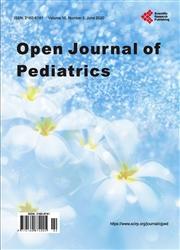Research Progress in Bronchopulmonary Dysplasia: A Narrative Review by Etiology
引用次数: 0
Abstract
Background: Bronchopulmonary Dysplasia (BPD) is a chronic lung condition that primarily affects preterm infants. Genetic predispositions, environmental factors, prenatal, and postnatal risk factors have been associated with bronchopulmonary dysplasia. However, there is a lack of consensus regarding these factors. Purpose: To examine the available information on pathogenesis and summarize the points of agreement to generate concise information that can guide patient management and spur further research. Method: PubMed, Embase and Web of Science were used to search for studies that analyzed the risk factors associated with bronchopulmonary dysplasia between 2006 and 2022 with the key search terms “bronchopulmonary dysplasia, etiology, preterm birth, mechanical ventilation”. Results: This study found that the pathogenesis of bronchopulmonary dysplasia is multifactorial, involving close interactions among these major etiological factors and other minor risk factors. A combination of mechanical ventilation, intrauterine factors, inflammation, genetic predispositions, insufficient surfactants, docosahexaenoic acid, and nutrition, among other minor risk factors, was all required in one way or another to influence BPD development. Therefore, studies should continuously update and incorporate the emerging information to assist frontline healthcare workers and generate qualitative data for clinical trial design and further research. Conclusion: Bronchopulmonary Dysplasia is different from other respiratory illnesses, and the pathogenesis of bronchopulmonary is multifactorial.支气管肺发育不良的病因学研究进展
背景:支气管肺发育不良(BPD)是一种主要影响早产儿的慢性肺部疾病。遗传易感性、环境因素、产前和产后危险因素与支气管肺发育不良有关。然而,对这些因素缺乏共识。目的:对现有的有关该病发病机制的资料进行梳理,总结共识点,以提供简明的信息,指导患者管理,促进进一步的研究。方法:以“支气管肺发育不良、病因、早产、机械通气”为关键词,采用PubMed、Embase和Web of Science检索2006 - 2022年支气管肺发育不良相关危险因素分析研究。结果:本研究发现支气管肺发育不良的发病机制是多因素的,这些主要病因与其他次要危险因素之间存在密切的相互作用。机械通气、宫内因素、炎症、遗传易感性、表面活性剂不足、二十二碳六烯酸和营养以及其他次要危险因素的组合,都以某种方式影响BPD的发展。因此,研究应不断更新和纳入新出现的信息,以帮助一线医护人员,并为临床试验设计和进一步研究生成定性数据。结论:支气管肺发育不良不同于其他呼吸系统疾病,其发病机制是多因素的。
本文章由计算机程序翻译,如有差异,请以英文原文为准。
求助全文
约1分钟内获得全文
求助全文

 求助内容:
求助内容: 应助结果提醒方式:
应助结果提醒方式:


